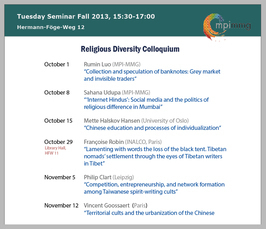"Territorial cults and the urbanization of the Chinese world: A case study of Suzhou"
Religious Diversity Colloquium Winter 2013/14
- Date: Nov 12, 2013
- Time: 03:30 PM - 05:00 PM (Local Time Germany)
- Speaker: Vincent Goossaert (Ecole Pratique des Hautes Etudes, Paris)
- Vincent Goossaert obtained his PhD at EPHE, Paris (1997), was a research fellow at CNRS from 1998 to 2012 and is now Professor of Daoism and Chinese religions at EPHE. He has served as the Deputy Director of the Societies-Religions-Secularisms Institute (GSRL, Paris) since 2004. In 2007, he was ICS Visiting Professor at the Chinese University of Hong Kong. His research deals with the social history of premodern and modern Chinese religion. He has published books on Chinese temples, Anticlericalism in China, Chinese dietary taboos, the production of moral norms, and most recently, with David Palmer, The Religious Question in Modern China (University of Chicago Press, 2011) which won the Levenson Prize for Books in Chinese Studies in 2013.
- Location: MPI-MMG, Hermann-Föge-Weg 12, Göttingen
- Room: Conference Room

For more details please contact vdvoffice(at)mmg.mpg.de.
Territory is one of the most important dimensions of Chinese socio-religious organization. Up to 1949, large cities were organized as networks of neighborhoods each with their own territorial god and temple. The territorial temple was where births and deaths were reported (to the gods), and where local affairs were managed. Local religious life has resumed since the late 1970s, but for political and developmental reasons, the vast majority of urban neighborhoods have not been able to restore their temples. This had led to a chasm between city (where religious grouping is by and large voluntary) and countryside, where territorial structures have survived to some degree. But, the situation is much more complex than a simple urban/rural divide, as territoriality still exists in the urban imaginaire and ritual repertoire; furthermore, the line between city and countryside is blurred and ever-moving due to massive urbanization and industrialization of suburban zones. There, the transformation of villages into urban districts involves tensions and negotiations about territoriality, and the territorial temples in particular.
This chapter, based on a case study of Suzhou but also drawing examples from other cities in the same Jiangnan region, aims to sketch this historical transformation, starting from the operation of socio-religious territories in pre-1949 Suzhou. It will then discuss who has retained memories of this territorial organization, and in what kind of context these memories still function. Then, it will focus on the process of transforming villages into urban districts and examine what becomes of the village gods. In a number of cases, these gods are themselves, like their believers, forcibly grouped in large official temples—divine housing estates, as it were—, where they come under the control of the Patriotic Daoist association. Yet, because they have two millennia of experience in negotiating with the centripetal forces of the urban clerical authorities, displaced villagers manage to some extent to retain their own territorial identity and ritual life under the new centralized institutional framework.